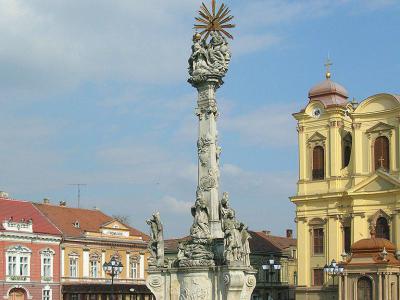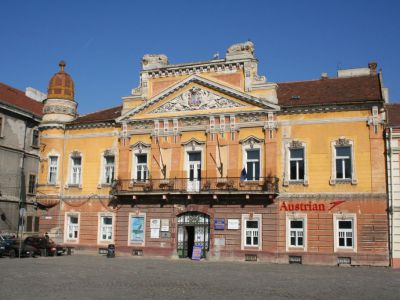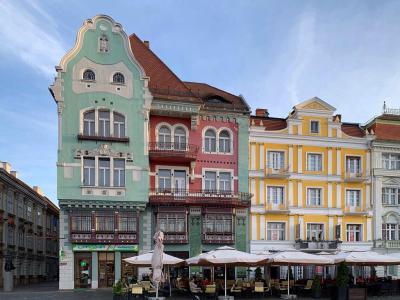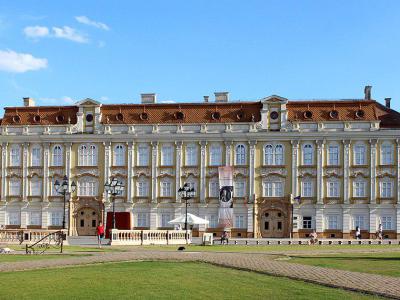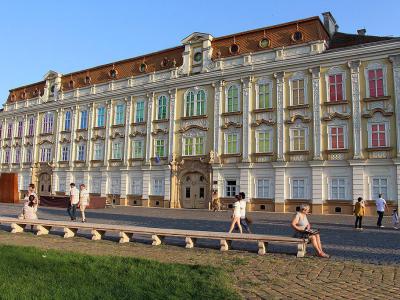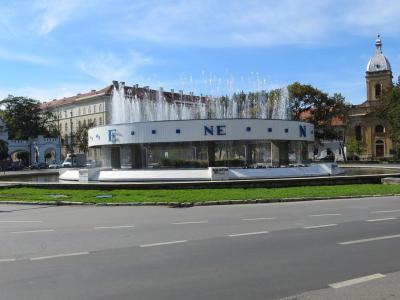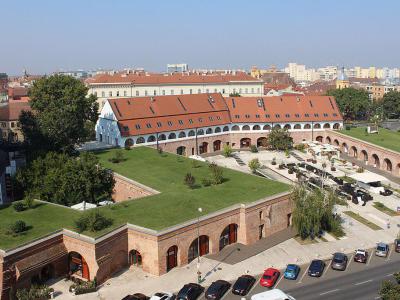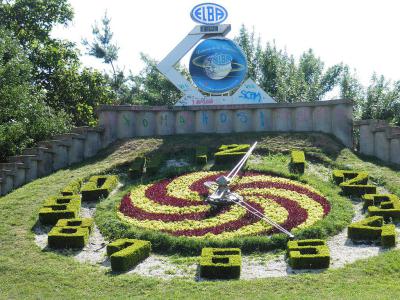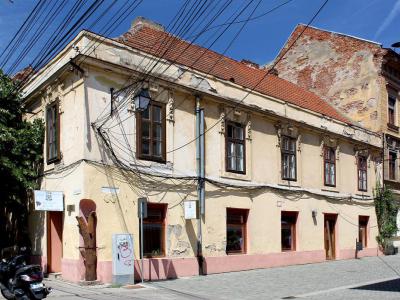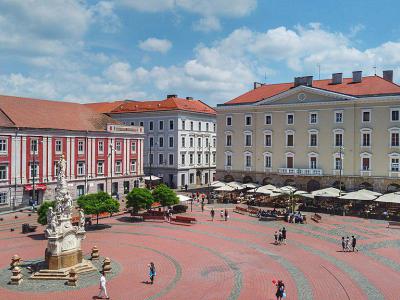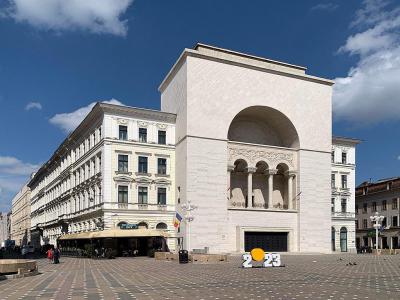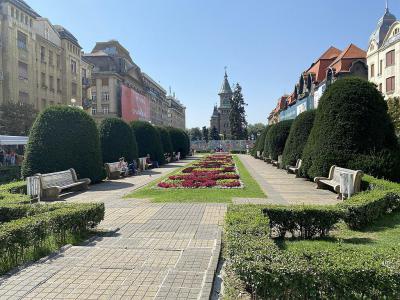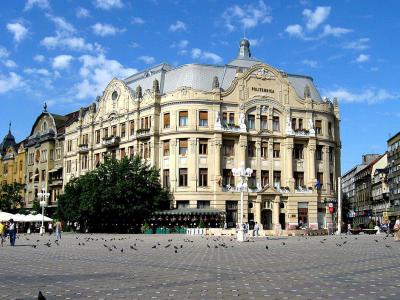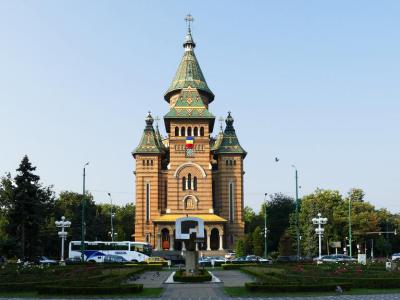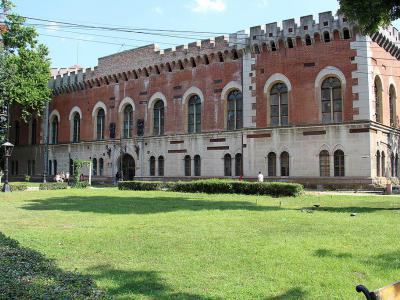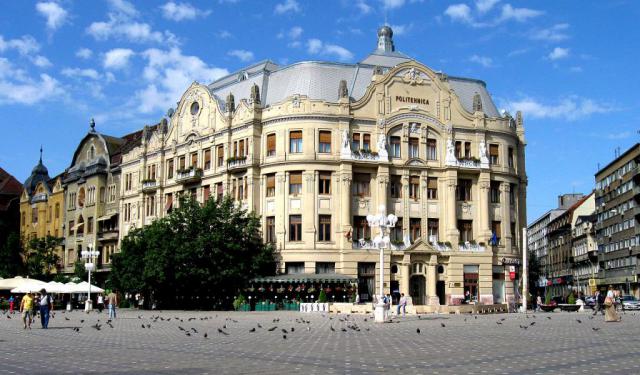Timisoara Introduction Walking Tour (Self Guided), Timisoara
One of the largest cities in Romania, Timisoara holds an honorary spot on one's travel map. One will be thrilled with the city’s harmoniously grouped landmarks and of course, it is incredible that the city houses quite a number of squares with historical value. Are you curious to visit Timisoara? Check out the city’s prominent landmarks.
How it works: Download the app "GPSmyCity: Walks in 1K+ Cities" from Apple App Store or Google Play Store to your mobile phone or tablet. The app turns your mobile device into a personal tour guide and its built-in GPS navigation functions guide you from one tour stop to next. The app works offline, so no data plan is needed when traveling abroad.
Timisoara Introduction Walking Tour Map
Guide Name: Timisoara Introduction Walking Tour
Guide Location: Romania » Timisoara (See other walking tours in Timisoara)
Guide Type: Self-guided Walking Tour (Sightseeing)
# of Attractions: 15
Tour Duration: 2 Hour(s)
Travel Distance: 3.6 Km or 2.2 Miles
Author: HelenF
Sight(s) Featured in This Guide:
Guide Location: Romania » Timisoara (See other walking tours in Timisoara)
Guide Type: Self-guided Walking Tour (Sightseeing)
# of Attractions: 15
Tour Duration: 2 Hour(s)
Travel Distance: 3.6 Km or 2.2 Miles
Author: HelenF
Sight(s) Featured in This Guide:
- Sfânta Treime Statue (Holy Trinity Statue)
- Casa cu Lei (House with Lions)
- Palatul Bruck (Bruck House)
- Baroque Palace
- Timisoara Art Museum
- Cardinal Point Fountain
- Maria Theresia Bastion
- Ceasul Floral (Floral Clock)
- Copacul Breslelor (Guilds Tree)
- Piata Libertatii (Liberty Square)
- National Opera House
- Piata Victoriei (Victory Square)
- Palatul Lloyd (Lloyd Palace)
- Timisoara Orthodox Cathedral
- Castelul Huniade (Huniade Castle)
1) Sfânta Treime Statue (Holy Trinity Statue) (must see)
The Holy Trinity Statue stands at the heart of Union Square, one of Timisoara’s most beautiful public spaces. Erected in 1740, the monument was commissioned in gratitude for the city’s survival of the devastating plague that swept across the Banat region in the early 18th century. It also served as a votive symbol of protection against future calamities such as war, famine, or disease, blending spiritual devotion with civic pride. Its placement in the square makes it not only a religious landmark but also a historical marker of the city’s resilience.
The statue reflects the late Baroque style, characterized by rich ornamentation and dramatic effect. At the top, the Holy Trinity-Father, Son, and Holy Spirit-is represented in a cloud of angels. Below them, saints associated with protection against plague and hardship, such as Saint Roch and Saint Sebastian, are depicted with lifelike detail. Allegorical figures and elaborate reliefs contribute to the monument’s striking presence, while its tall column form echoes similar plague memorials found across Central Europe, especially in Austria and Hungary.
For visitors, the Holy Trinity Statue is more than just an artistic gem. It connects Timisoara to a broader European tradition of votive monuments erected in the aftermath of epidemics, revealing how faith and art merged in public expressions of hope. Surrounded by colorful Baroque and Secessionist palaces, the monument serves as a focal point for the square, drawing the eye amid the architectural ensemble. It remains a powerful reminder of the city’s struggles and triumphs, offering both locals and tourists a chance to reflect on Timisoara’s enduring spirit.
The statue reflects the late Baroque style, characterized by rich ornamentation and dramatic effect. At the top, the Holy Trinity-Father, Son, and Holy Spirit-is represented in a cloud of angels. Below them, saints associated with protection against plague and hardship, such as Saint Roch and Saint Sebastian, are depicted with lifelike detail. Allegorical figures and elaborate reliefs contribute to the monument’s striking presence, while its tall column form echoes similar plague memorials found across Central Europe, especially in Austria and Hungary.
For visitors, the Holy Trinity Statue is more than just an artistic gem. It connects Timisoara to a broader European tradition of votive monuments erected in the aftermath of epidemics, revealing how faith and art merged in public expressions of hope. Surrounded by colorful Baroque and Secessionist palaces, the monument serves as a focal point for the square, drawing the eye amid the architectural ensemble. It remains a powerful reminder of the city’s struggles and triumphs, offering both locals and tourists a chance to reflect on Timisoara’s enduring spirit.
2) Casa cu Lei (House with Lions) (must see)
In the heart of Timisoara’s Union Square stands one of the city’s most distinctive Baroque landmarks: House with Lions (Casa cu Lei). Built in 1758, this palace originally appeared on city plans as the Palick House, named after its first known owner. Its prominent location on the northwestern side of the square made it a focal point of urban life, and over the centuries, it has witnessed both prosperity and political upheaval. Today, it is recognized as a historical monument and forms part of the protected ensemble of the old Timișoara Fortress.
The building has worn many identities. In the early 19th century, it was called the Palick House, later serving as the Golden Sun eating house, the White Dog grocery store, and the Big Whistle shop-an indication of how the square bustled with commerce and conviviality. In 1871, businessman Sándor Weisz purchased the property after it passed through several hands, establishing a renowned haberdashery and wholesale enterprise there. His son, Lajos Weisz, eventually enlarged the warehouse on the ground floor and oversaw a major renovation of the façade in 1906.
It was during that renovation that the palace gained its most recognizable feature: the pair of life-size lions placed on the attic above the central pediment. The shield beneath them, adorned with four crossed swords forming the letter “W” for Weisz, is supported by griffins, while the façade itself is enlivened with floral motifs, Ionic pilasters, and a rounded corner oriel that dates back to before 1840. The style blends the original Austrian Baroque structure with early 20th-century Secessionist flair, giving the building its layered character.
The House with Lions also has a darker chapter in its history. In the 1950s, during the socialist regime, the building became the headquarters of the Siguranta, the forerunner of the dreaded Securitate secret police. Its cellars were repurposed as detention centers, a stark contrast to its earlier life as a hub of trade and social life. For visitors today, the palace embodies Timișoara’s complex past-an elegant but weathered reminder of shifting fortunes, cultural intersections, and the city’s enduring spirit.
The building has worn many identities. In the early 19th century, it was called the Palick House, later serving as the Golden Sun eating house, the White Dog grocery store, and the Big Whistle shop-an indication of how the square bustled with commerce and conviviality. In 1871, businessman Sándor Weisz purchased the property after it passed through several hands, establishing a renowned haberdashery and wholesale enterprise there. His son, Lajos Weisz, eventually enlarged the warehouse on the ground floor and oversaw a major renovation of the façade in 1906.
It was during that renovation that the palace gained its most recognizable feature: the pair of life-size lions placed on the attic above the central pediment. The shield beneath them, adorned with four crossed swords forming the letter “W” for Weisz, is supported by griffins, while the façade itself is enlivened with floral motifs, Ionic pilasters, and a rounded corner oriel that dates back to before 1840. The style blends the original Austrian Baroque structure with early 20th-century Secessionist flair, giving the building its layered character.
The House with Lions also has a darker chapter in its history. In the 1950s, during the socialist regime, the building became the headquarters of the Siguranta, the forerunner of the dreaded Securitate secret police. Its cellars were repurposed as detention centers, a stark contrast to its earlier life as a hub of trade and social life. For visitors today, the palace embodies Timișoara’s complex past-an elegant but weathered reminder of shifting fortunes, cultural intersections, and the city’s enduring spirit.
3) Palatul Bruck (Bruck House) (must see)
The Bruck House (Palatul Bruck) is one of Timisoara’s most distinctive landmarks, located in the heart of Victory Square. Its story begins with a pharmacy established on the site in 1898, known as the Golden Cross. Owned initially by the Geml family-though some sources mention the Zifkovich family-the pharmacy was later refurbished and managed by Salamon Bruck, whose name the building still carries. Remarkably, the pharmacy continues to operate today, retaining much of its original furniture and display cases, which adds a living layer of history to the site.
The current structure was built between 1910 and 1911, replacing the earlier Viennese Baroque-style building with a new design in the fashionable Secession style. The project was overseen by Laszlo Szekely, Timisoara’s chief architect at the time, who collaborated with Arnold Merbl. To monitor the construction closely, Merbl even lived in a wooden shack on the site until the works were completed. The result was a strikingly slender building, often compared to a slice of cake, which immediately stood out in the square’s architectural ensemble.
Architecturally, the Bruck House reflects both Art Nouveau and Secession influences, with a number of unique features. Unlike many other Secession buildings, its corners were left sharp rather than rounded, signaling a break from tradition. The façade is decorated with ceramic tiles featuring Hungarian folk motifs, while the initials “BS,” for Salamon Bruck, are inscribed on the pediment. The structure, built with thick brick walls and vaulted ceilings, includes a basement, ground floor, and three upper stories. Distinctive elements such as two-level bow windows, closed balconies with glazed curtain walls, and an intricately shaped roof highlight its Secession character.
After falling into disrepair in the years following 1989, the Bruck House was saved by a major renovation in 2012, initiated by an Italian businessman who had purchased an apartment in the building in the late 1990s. Today, it stands once again in restored splendor, symbolizing both Timisoara’s architectural heritage and its resilience. For visitors, the Bruck House offers not only a glimpse into the city’s Art Nouveau legacy but also an enduring link to everyday life through its still-functioning historic pharmacy.
The current structure was built between 1910 and 1911, replacing the earlier Viennese Baroque-style building with a new design in the fashionable Secession style. The project was overseen by Laszlo Szekely, Timisoara’s chief architect at the time, who collaborated with Arnold Merbl. To monitor the construction closely, Merbl even lived in a wooden shack on the site until the works were completed. The result was a strikingly slender building, often compared to a slice of cake, which immediately stood out in the square’s architectural ensemble.
Architecturally, the Bruck House reflects both Art Nouveau and Secession influences, with a number of unique features. Unlike many other Secession buildings, its corners were left sharp rather than rounded, signaling a break from tradition. The façade is decorated with ceramic tiles featuring Hungarian folk motifs, while the initials “BS,” for Salamon Bruck, are inscribed on the pediment. The structure, built with thick brick walls and vaulted ceilings, includes a basement, ground floor, and three upper stories. Distinctive elements such as two-level bow windows, closed balconies with glazed curtain walls, and an intricately shaped roof highlight its Secession character.
After falling into disrepair in the years following 1989, the Bruck House was saved by a major renovation in 2012, initiated by an Italian businessman who had purchased an apartment in the building in the late 1990s. Today, it stands once again in restored splendor, symbolizing both Timisoara’s architectural heritage and its resilience. For visitors, the Bruck House offers not only a glimpse into the city’s Art Nouveau legacy but also an enduring link to everyday life through its still-functioning historic pharmacy.
4) Baroque Palace (must see)
The Baroque Palace is one of the city’s most elegant landmarks and a symbol of its Habsburg-era transformation. Built between 1752 and 1754 as the episcopal residence of the Roman Catholic Diocese of Timisoara, the palace originally stood as a testament to the city’s renewed importance after the Habsburgs reclaimed the Banat from Ottoman rule. Designed in the Viennese Baroque style and later remodeled with neo-Renaissance touches, its stately façade of pilasters, pediments, and ornate windows reflects the Central European influences that shaped Timișoara’s architectural identity.
The palace occupies a prime position facing the Metropolitan Cathedral across Victory Square, creating a striking dialogue between Orthodox and Catholic traditions in a city often celebrated for its multicultural harmony. Over the centuries, the building has undergone several transformations, including significant 19th-century renovations under Bishop Alexander Dessewffy, which added Renaissance details and emphasized its monumental presence in the urban landscape. The contrast between its exuberant Baroque forms and the Neo-Byzantine domes of the cathedral across the square underscores Timișoara’s diverse religious heritage.
Today, the Baroque Palace houses the National Museum of Art, a cultural highlight for visitors. Its galleries feature an impressive collection of European, Romanian, and Banat regional art, with works spanning medieval icons, Renaissance paintings, and 20th-century masterpieces, including creations by the celebrated local artist Corneliu Baba. Beyond the artworks, the museum’s interior itself-decorated with stucco ornaments, vaulted ceilings, and grand halls-offers a glimpse into the opulence of Timișoara’s aristocratic past.
Exploring the Baroque Palace is both an artistic journey and a historical encounter. Visitors not only admire the treasures within its walls but also sense the layers of history embedded in its architecture and setting. Standing at the crossroads of cultures and eras, the palace embodies Timișoara’s unique character, making it an essential stop for anyone seeking to understand the city’s rich heritage.
The palace occupies a prime position facing the Metropolitan Cathedral across Victory Square, creating a striking dialogue between Orthodox and Catholic traditions in a city often celebrated for its multicultural harmony. Over the centuries, the building has undergone several transformations, including significant 19th-century renovations under Bishop Alexander Dessewffy, which added Renaissance details and emphasized its monumental presence in the urban landscape. The contrast between its exuberant Baroque forms and the Neo-Byzantine domes of the cathedral across the square underscores Timișoara’s diverse religious heritage.
Today, the Baroque Palace houses the National Museum of Art, a cultural highlight for visitors. Its galleries feature an impressive collection of European, Romanian, and Banat regional art, with works spanning medieval icons, Renaissance paintings, and 20th-century masterpieces, including creations by the celebrated local artist Corneliu Baba. Beyond the artworks, the museum’s interior itself-decorated with stucco ornaments, vaulted ceilings, and grand halls-offers a glimpse into the opulence of Timișoara’s aristocratic past.
Exploring the Baroque Palace is both an artistic journey and a historical encounter. Visitors not only admire the treasures within its walls but also sense the layers of history embedded in its architecture and setting. Standing at the crossroads of cultures and eras, the palace embodies Timișoara’s unique character, making it an essential stop for anyone seeking to understand the city’s rich heritage.
5) Timisoara Art Museum (must see)
The Timisoara Art Museum, located in the historic Baroque Palace of Union Square, offers visitors a refined encounter with both local and international art. Established in 2006, the museum has quickly become one of the city’s leading cultural institutions, drawing attention not only for its impressive collections but also for its setting inside an 18th-century palace that once served as an administrative centre of the Habsburg Empire. Its location in the heart of Union Square makes it a natural stop for anyone exploring Timisoara’s architectural and cultural landmarks.
Inside, the museum presents a wide range of works spanning several centuries. The permanent collection highlights Romanian masters such as Corneliu Baba, whose emotionally charged paintings hold a central place, alongside decorative arts, icons, and contemporary pieces that reflect the region’s diverse heritage. Temporary exhibitions often bring in works from European and international artists, ensuring a dynamic program that appeals to casual visitors as well as dedicated art enthusiasts.
The museum’s interior complements its collections with elegant exhibition halls, high ceilings, and restored details that echo the palace’s Baroque origins. Visitors can move seamlessly between historic and modern contexts, appreciating both the artwork on display and the building itself as a piece of cultural heritage. Beyond the exhibitions, the museum also engages the community with lectures, workshops, and cultural events that contribute to Timisoara’s role as a European Capital of Culture.
For tourists, the Timisoara Art Museum is more than a gallery-it is a bridge between the city’s imperial past and its contemporary creative energy. Its combination of historic architecture and diverse art makes it a memorable stop, offering insight into the cultural identity of Banat and the broader Romanian art scene.
Inside, the museum presents a wide range of works spanning several centuries. The permanent collection highlights Romanian masters such as Corneliu Baba, whose emotionally charged paintings hold a central place, alongside decorative arts, icons, and contemporary pieces that reflect the region’s diverse heritage. Temporary exhibitions often bring in works from European and international artists, ensuring a dynamic program that appeals to casual visitors as well as dedicated art enthusiasts.
The museum’s interior complements its collections with elegant exhibition halls, high ceilings, and restored details that echo the palace’s Baroque origins. Visitors can move seamlessly between historic and modern contexts, appreciating both the artwork on display and the building itself as a piece of cultural heritage. Beyond the exhibitions, the museum also engages the community with lectures, workshops, and cultural events that contribute to Timisoara’s role as a European Capital of Culture.
For tourists, the Timisoara Art Museum is more than a gallery-it is a bridge between the city’s imperial past and its contemporary creative energy. Its combination of historic architecture and diverse art makes it a memorable stop, offering insight into the cultural identity of Banat and the broader Romanian art scene.
6) Cardinal Point Fountain
At one of Timisoara’s busiest crossroads, where several avenues converge, you’ll find the lively spectacle of the Cardinal Point Fountain. This landmark, created in the 1970s, takes its name from the four cardinal directions, each represented by a graceful bronze figure set against a spray of water. The fountain quickly became more than an urban ornament-it turned into a gathering point for locals and a landmark that helps visitors orient themselves in the city’s modern districts. Its location at the junction of major boulevards makes it a natural reference point, much like a compass at the centre of a map.
What draws many people here is the fountain’s unique design. Rising from a circular basin, four bronze statues-symbolizing North, South, East, and West-face outward, each holding objects tied to exploration, progress, or cultural identity. Water cascades around them, softening the stone surroundings with movement and sound. At night, the fountain comes alive with colourful illumination, adding a dynamic glow to the square and creating a striking contrast with the city lights.
Beyond its decorative role, the fountain has become part of daily life in Timisoara. People meet friends here before heading to cafés, students linger after class, and during festivals, the square around it often hosts music, parades, or open-air markets. The continuous play of water offers a welcome coolness in the summer months, making it a favourite resting point for both residents and visitors.
For travellers, the Cardinal Point Fountain is more than just a photogenic stop: it’s a symbol of Timisoara’s openness and its position as a crossroads of cultures in the Banat region. Pausing here allows you to watch the rhythm of the city flow by-trams clattering past, pedestrians hurrying to shops, and families enjoying the public space.
What draws many people here is the fountain’s unique design. Rising from a circular basin, four bronze statues-symbolizing North, South, East, and West-face outward, each holding objects tied to exploration, progress, or cultural identity. Water cascades around them, softening the stone surroundings with movement and sound. At night, the fountain comes alive with colourful illumination, adding a dynamic glow to the square and creating a striking contrast with the city lights.
Beyond its decorative role, the fountain has become part of daily life in Timisoara. People meet friends here before heading to cafés, students linger after class, and during festivals, the square around it often hosts music, parades, or open-air markets. The continuous play of water offers a welcome coolness in the summer months, making it a favourite resting point for both residents and visitors.
For travellers, the Cardinal Point Fountain is more than just a photogenic stop: it’s a symbol of Timisoara’s openness and its position as a crossroads of cultures in the Banat region. Pausing here allows you to watch the rhythm of the city flow by-trams clattering past, pedestrians hurrying to shops, and families enjoying the public space.
7) Maria Theresia Bastion (must see)
The Maria Theresia Bastion is one of the most impressive remnants of Timisoara’s old fortress, a striking reminder of the city’s military past. Built between 1732 and 1734 during the Habsburg era, the bastion was named after Empress Maria Theresa of Austria. It formed part of the vast Vauban-style fortifications that once encircled the city, designed to secure the Banat region after it was reclaimed from Ottoman control in 1716. Stretching across an imposing section of brick walls and passageways, it stands today as the largest preserved segment of these 18th-century defenses.
Though originally built for military purposes, the bastion never saw actual combat, as its construction coincided with a relatively peaceful period in the region. Instead, its history is tied to Timisoara’s transformation into an important administrative and cultural hub under Habsburg rule. Over time, the fortress walls lost their defensive function, and much of the fortification system was dismantled in the 19th century to make way for urban expansion. The Maria Theresia Bastion, however, survived and was later adapted for civilian use.
Today, the bastion is a vibrant cultural and commercial space, seamlessly blending history with modern life. Visitors can explore its arched passageways, where cafés, restaurants, shops, and exhibition halls bring activity back into the centuries-old brick walls. The site also frequently hosts cultural events, making it both a historical landmark and a lively meeting point for locals and tourists. For those interested in Timisoara’s layered history, the Maria Theresia Bastion offers a rare opportunity to step inside the city’s 18th-century defenses while enjoying the rhythm of its modern-day life.
Though originally built for military purposes, the bastion never saw actual combat, as its construction coincided with a relatively peaceful period in the region. Instead, its history is tied to Timisoara’s transformation into an important administrative and cultural hub under Habsburg rule. Over time, the fortress walls lost their defensive function, and much of the fortification system was dismantled in the 19th century to make way for urban expansion. The Maria Theresia Bastion, however, survived and was later adapted for civilian use.
Today, the bastion is a vibrant cultural and commercial space, seamlessly blending history with modern life. Visitors can explore its arched passageways, where cafés, restaurants, shops, and exhibition halls bring activity back into the centuries-old brick walls. The site also frequently hosts cultural events, making it both a historical landmark and a lively meeting point for locals and tourists. For those interested in Timisoara’s layered history, the Maria Theresia Bastion offers a rare opportunity to step inside the city’s 18th-century defenses while enjoying the rhythm of its modern-day life.
8) Ceasul Floral (Floral Clock)
The Floral Clock (Ceasul Floral) is one of Timisoara’s most beloved landmarks, combining the precision of timekeeping with the elegance of horticultural design. Installed in 1971 on the edge of the city’s historic centre, the clock was created during a period when Timisoara was actively developing its parks and public gardens. Its face, made up of thousands of colorful flowers that change with the seasons, spans several meters in diameter and is set into a gentle slope, making it visible from afar. Unlike a painted decoration, the “dial” is alive, carefully replanted to reflect the time of year, ensuring that the Floral Clock is never quite the same from one visit to the next.
The idea of the floral clock reflects Timisoara’s long-standing reputation as a “city of parks and gardens.” Since the 19th century, the city has prided itself on its public green spaces, and the installation of the Ceasul Floral was both a celebration of horticultural artistry and a nod to the city’s embrace of modern design. The clock’s mechanical components operate beneath the flowerbed, moving the hands with remarkable accuracy. This blend of natural beauty and precise engineering mirrors Timisoara’s historical role as a meeting point between cultures and traditions in the Banat region.
Today, the Floral Clock continues to delight visitors strolling through the city. In spring and summer, its face bursts into life with vibrant blooms arranged in intricate patterns, while autumn brings warmer, earthy tones. Beyond its aesthetic appeal, the clock has become a symbol of Timisoara’s vitality and care for public space, an emblem of the city’s identity as a place where art, nature, and community flourish together.
The idea of the floral clock reflects Timisoara’s long-standing reputation as a “city of parks and gardens.” Since the 19th century, the city has prided itself on its public green spaces, and the installation of the Ceasul Floral was both a celebration of horticultural artistry and a nod to the city’s embrace of modern design. The clock’s mechanical components operate beneath the flowerbed, moving the hands with remarkable accuracy. This blend of natural beauty and precise engineering mirrors Timisoara’s historical role as a meeting point between cultures and traditions in the Banat region.
Today, the Floral Clock continues to delight visitors strolling through the city. In spring and summer, its face bursts into life with vibrant blooms arranged in intricate patterns, while autumn brings warmer, earthy tones. Beyond its aesthetic appeal, the clock has become a symbol of Timisoara’s vitality and care for public space, an emblem of the city’s identity as a place where art, nature, and community flourish together.
9) Copacul Breslelor (Guilds Tree)
In the northwest corner of Union Square in Timisoara, you’ll find one of the city’s most photographed landmarks: the Guilds Tree (Copacul Breslelor). This striking monument is not a tree at all but a symbolic sculpture that pays homage to the many guilds that once shaped the city’s social and economic life. In the 18th and 19th centuries, Timisoara’s artisans-blacksmiths, tailors, shoemakers, goldsmiths, and bakers-formed guilds that not only regulated their trades but also played an important role in civic and cultural affairs. The Guilds Tree was conceived as a tribute to this legacy, a reminder of the skill and community spirit that helped transform Timisoara into one of Central Europe’s most prosperous cities.
The design is as evocative as its name suggests. Rising from a sturdy base, the “tree” branches outward in an ornate fashion, with each section symbolizing a different guild. The details recall the era when craftsmanship was at the core of civic identity-whether through tools, motifs, or heraldic emblems once proudly displayed on guild banners. The structure stands as a kind of stone chronicle, narrating the story of a city built on artisanal excellence and collective endeavor.
Visitors to Union Square often pause by the Guilds Tree to study these sculpted emblems up close. Each detail hints at a trade that once defined daily life here, from the production of fine clothing to the baking of bread for the community. Today, surrounded by pastel-coloured Baroque and Rococo facades, the monument connects the lively café-lined square to a deeper history, reminding passersby that behind every ornate palace and cobbled street are generations of craftspeople whose work laid the foundations for modern Timișoara.
The design is as evocative as its name suggests. Rising from a sturdy base, the “tree” branches outward in an ornate fashion, with each section symbolizing a different guild. The details recall the era when craftsmanship was at the core of civic identity-whether through tools, motifs, or heraldic emblems once proudly displayed on guild banners. The structure stands as a kind of stone chronicle, narrating the story of a city built on artisanal excellence and collective endeavor.
Visitors to Union Square often pause by the Guilds Tree to study these sculpted emblems up close. Each detail hints at a trade that once defined daily life here, from the production of fine clothing to the baking of bread for the community. Today, surrounded by pastel-coloured Baroque and Rococo facades, the monument connects the lively café-lined square to a deeper history, reminding passersby that behind every ornate palace and cobbled street are generations of craftspeople whose work laid the foundations for modern Timișoara.
10) Piata Libertatii (Liberty Square) (must see)
Liberty Square (Piata Libertatii) is one of the most historically layered spaces in Timisoara, known as the city’s second-oldest square. Originally a crossroads for three medieval trade routes, it evolved from a triangular open area into a planned, rectangular urban square during the Habsburg reconstruction of the 18th century. Over the centuries, it has carried several names, from Paradeplatz, when it was a training ground for imperial recruits, to Prince Eugene Square in the 1800s, honoring Eugene of Savoy, who freed Timisoara from Ottoman rule in 1716. Its current name, Liberty Square, dates back to 1848 and has been in use continuously since 1921, symbolizing resilience during the turbulent years of revolution and siege.
The square preserves some of Timisoara’s oldest buildings, including the Garrison Command, the former Chancellery of War, the Old City Hall, and the Military Casino. The latter, a fine example of Baroque architecture with Rococo touches, hints at the square’s military and administrative significance under Austrian rule. Other structures, mainly from the early 20th century, add classicist facades that frame the square in a uniform, dignified style. For centuries, Liberty Square also functioned as the city’s central market, where food, animals, and weekly commerce brought bustle until trade moved to Union Square in 1903.
Beyond its buildings, Liberty Square’s ground tells a layered story. On its eastern side once stood the Big Bath, the city’s largest public bath under Ottoman rule, mentioned by the traveler Evliya Celebi. Later, the ruins of a Turkish bazaar gave way to military and civic constructions, gradually transforming the square into a closed, orderly urban space by the mid-19th century. Its dimensions, finalized in the 1740s, remain almost unchanged at 103 by 99 meters.
Today, Liberty Square blends its history with a modern touch. A major rehabilitation project in 2015 redefined its surface with concentric red brick paving, adding a clean, contemporary look to the centuries-old setting. Walking through the square, visitors can sense its shifting roles across time-from Ottoman baths to Habsburg drills, bustling markets, and now a cultural gathering spot at the heart of Timisoara’s old fortress.
The square preserves some of Timisoara’s oldest buildings, including the Garrison Command, the former Chancellery of War, the Old City Hall, and the Military Casino. The latter, a fine example of Baroque architecture with Rococo touches, hints at the square’s military and administrative significance under Austrian rule. Other structures, mainly from the early 20th century, add classicist facades that frame the square in a uniform, dignified style. For centuries, Liberty Square also functioned as the city’s central market, where food, animals, and weekly commerce brought bustle until trade moved to Union Square in 1903.
Beyond its buildings, Liberty Square’s ground tells a layered story. On its eastern side once stood the Big Bath, the city’s largest public bath under Ottoman rule, mentioned by the traveler Evliya Celebi. Later, the ruins of a Turkish bazaar gave way to military and civic constructions, gradually transforming the square into a closed, orderly urban space by the mid-19th century. Its dimensions, finalized in the 1740s, remain almost unchanged at 103 by 99 meters.
Today, Liberty Square blends its history with a modern touch. A major rehabilitation project in 2015 redefined its surface with concentric red brick paving, adding a clean, contemporary look to the centuries-old setting. Walking through the square, visitors can sense its shifting roles across time-from Ottoman baths to Habsburg drills, bustling markets, and now a cultural gathering spot at the heart of Timisoara’s old fortress.
11) National Opera House (must see)
The National Opera House of Timisoara is one of the city’s most iconic landmarks, both for its grand architecture and its cultural significance. Built between 1871 and 1875, the building was designed by the Viennese architects Ferdinand Fellner and Hermann Helmer, who also created similar theaters across Central Europe. Its imposing façade, blending Renaissance and Byzantine elements, stands proudly at Victory Square, where it has long served as a cultural anchor and a symbol of the city’s vibrant artistic life. Despite being damaged by fire several times in its history, the opera house has always been restored, reinforcing its importance to Timișoara’s identity.
Inside, the building is home not only to the Romanian National Opera but also to three other state theaters: the German State Theatre, the Hungarian State Theatre, and the Timișoara National Theatre. This unique coexistence of institutions under one roof highlights the multicultural character of the Banat region, where Romanians, Hungarians, Germans, and other ethnic groups have coexisted side by side for centuries. For visitors, this makes the Opera House more than just a performance venue-it is a testament to Timișoara’s cultural diversity and openness.
The Opera House regularly hosts operas, ballets, and concerts, as well as theater productions in multiple languages, making it a lively centre of the city’s cultural calendar. Its richly decorated interior, with ornate balconies and a grand stage, offers an atmosphere that enhances every performance. You might watch a classic opera, a modern play, or a concert, but any evening here offers a lasting glimpse into the cultural spirit of Timișoara.
Even if you don’t have time to attend a performance, the Opera House is worth visiting from the outside, as its monumental presence defines Victory Square. The square itself has witnessed major historic events, most famously the 1989 Revolution, when crowds gathered here to demand freedom from communist rule. Standing before the Opera House today, you experience not only the artistic pride of the city but also its enduring role as a stage for history.
Inside, the building is home not only to the Romanian National Opera but also to three other state theaters: the German State Theatre, the Hungarian State Theatre, and the Timișoara National Theatre. This unique coexistence of institutions under one roof highlights the multicultural character of the Banat region, where Romanians, Hungarians, Germans, and other ethnic groups have coexisted side by side for centuries. For visitors, this makes the Opera House more than just a performance venue-it is a testament to Timișoara’s cultural diversity and openness.
The Opera House regularly hosts operas, ballets, and concerts, as well as theater productions in multiple languages, making it a lively centre of the city’s cultural calendar. Its richly decorated interior, with ornate balconies and a grand stage, offers an atmosphere that enhances every performance. You might watch a classic opera, a modern play, or a concert, but any evening here offers a lasting glimpse into the cultural spirit of Timișoara.
Even if you don’t have time to attend a performance, the Opera House is worth visiting from the outside, as its monumental presence defines Victory Square. The square itself has witnessed major historic events, most famously the 1989 Revolution, when crowds gathered here to demand freedom from communist rule. Standing before the Opera House today, you experience not only the artistic pride of the city but also its enduring role as a stage for history.
12) Piata Victoriei (Victory Square) (must see)
Victory Square (Piata Victoriei) stands as the symbolic heart of Timisoara, carrying both architectural grandeur and deep historical meaning. Originally developed at the beginning of the 20th century after the demolition of the city’s old fortress walls, it was envisioned as a wide boulevard by architect Ludwig von Ybl in 1892. Over the years, the space gradually took on the form of a square, with construction beginning in earnest in 1910 with the Lloyd Palace. The southern end was eventually sealed by the monumental Metropolitan Cathedral, transforming the area into a striking urban ensemble.
The square is perhaps best remembered for the events of December 1989, when Timisoara became the first city in Romania to free itself from communist rule. On December 20, the square filled with crowds proclaiming their demand for liberty, and it has been associated with that spirit of courage and renewal ever since. Until then, the site bore various names: King Ferdinand Boulevard before World War II, 30 December Boulevard under the communist regime, and Opera Square until its renaming in 1990 as Victory Square.
Cultural life thrives here, framed by two defining landmarks-the National Opera House on the north and the Orthodox Metropolitan Cathedral on the south. Between them runs a pedestrian promenade divided into the elegant Corso on the right and the lively Surogat on the left. Along the way, visitors encounter architectural ensembles, cafés, galleries, and historic cinemas, which together create an atmosphere that bridges past and present.
Today, Victory Square is more than a historic landmark-it is Timisoara’s central gathering place. It hosts a wide array of cultural events such as the JazzTM festival, Timfloralis flower fair, and seasonal celebrations like Easter and Christmas markets. With its blend of history, architecture, and daily life, the square embodies both the legacy and the living pulse of Timisoara.
The square is perhaps best remembered for the events of December 1989, when Timisoara became the first city in Romania to free itself from communist rule. On December 20, the square filled with crowds proclaiming their demand for liberty, and it has been associated with that spirit of courage and renewal ever since. Until then, the site bore various names: King Ferdinand Boulevard before World War II, 30 December Boulevard under the communist regime, and Opera Square until its renaming in 1990 as Victory Square.
Cultural life thrives here, framed by two defining landmarks-the National Opera House on the north and the Orthodox Metropolitan Cathedral on the south. Between them runs a pedestrian promenade divided into the elegant Corso on the right and the lively Surogat on the left. Along the way, visitors encounter architectural ensembles, cafés, galleries, and historic cinemas, which together create an atmosphere that bridges past and present.
Today, Victory Square is more than a historic landmark-it is Timisoara’s central gathering place. It hosts a wide array of cultural events such as the JazzTM festival, Timfloralis flower fair, and seasonal celebrations like Easter and Christmas markets. With its blend of history, architecture, and daily life, the square embodies both the legacy and the living pulse of Timisoara.
13) Palatul Lloyd (Lloyd Palace) (must see)
The Lloyd Palace (Palatul Lloyd) is one of Timisoara’s most recognizable landmarks, standing proudly on Victory Square with its elegant Secession-style façade. Built between 1910 and 1912, the palace was designed by architect Lipót Baumhorn, a specialist in grand urban projects of the Austro-Hungarian era. Its name comes from the Lloyd Society, an association of Banat grain merchants who played an essential role in financing the project. The building originally served as a hub for commerce, administration, and social gatherings, reflecting the prosperity of Timisoara at the beginning of the 20th century.
Architecturally, the Lloyd Palace impresses with its symmetry and refined details, blending functional urban design with decorative artistry. Its façade is richly ornamented with floral motifs typical of the Secession style, while the grand arcades at street level emphasize its role as a meeting place for merchants and townsfolk. Over time, the palace became not only a commercial center but also a prestigious space for cultural and social life in Timisoara, housing offices, institutions, and popular cafés.
Today, the Lloyd Palace continues to serve the city in a new role. It houses the Rectorate of the West University of Timisoara, giving the building an academic significance while preserving its historical grandeur. Visitors often stop here to admire the exterior details, enjoy the atmosphere of Victory Square, and reflect on the layers of history that the building represents-from a merchants’ guild headquarters to a modern educational institution.
Visiting the Lloyd Palace is not only about appreciating its architecture but also about understanding Timisoara’s evolution through the centuries. Seen as part of the square’s larger setting or examined in detail, the building stands as a symbol of the city’s cultural and economic energy, linking its Habsburg-era prosperity with its modern academic character.
Architecturally, the Lloyd Palace impresses with its symmetry and refined details, blending functional urban design with decorative artistry. Its façade is richly ornamented with floral motifs typical of the Secession style, while the grand arcades at street level emphasize its role as a meeting place for merchants and townsfolk. Over time, the palace became not only a commercial center but also a prestigious space for cultural and social life in Timisoara, housing offices, institutions, and popular cafés.
Today, the Lloyd Palace continues to serve the city in a new role. It houses the Rectorate of the West University of Timisoara, giving the building an academic significance while preserving its historical grandeur. Visitors often stop here to admire the exterior details, enjoy the atmosphere of Victory Square, and reflect on the layers of history that the building represents-from a merchants’ guild headquarters to a modern educational institution.
Visiting the Lloyd Palace is not only about appreciating its architecture but also about understanding Timisoara’s evolution through the centuries. Seen as part of the square’s larger setting or examined in detail, the building stands as a symbol of the city’s cultural and economic energy, linking its Habsburg-era prosperity with its modern academic character.
14) Timisoara Orthodox Cathedral (must see)
Timisoara Orthodox Cathedral is one of the city’s most iconic landmarks and a centerpiece of Banat’s spiritual life. Built between 1936 and 1941, the cathedral was conceived as a symbol of Romania’s unity after the region of Banat was integrated into the country following World War I. Its architecture blends Neo-Moldavian and Byzantine elements, creating a distinctive silhouette with eleven soaring towers, the central spire reaching nearly 90 meters into the sky. The patterned brickwork, glazed ceramic tiles, and arched porticoes immediately set it apart from the surrounding Secessionist and Baroque façades of the city centre.
Inside, the atmosphere is serene and reverent. The interior walls are covered in elaborate frescoes painted over several decades, depicting biblical scenes and Romanian saints. One of the most striking features is the immense chandelier, suspended beneath the soaring central dome, which filters light onto the richly decorated nave. The crypt beneath the main sanctuary houses the remains of Metropolitan Bishop Vasile Lăzărescu, as well as a collection of icons and religious artifacts from across Banat, giving visitors a glimpse into centuries of regional faith and craftsmanship.
The cathedral also occupies a special place in Romania’s modern history. During the December 1989 Revolution, when Timisoara became the cradle of the uprising against Nicolae Ceaușescu’s regime, thousands of people gathered in front of this very church to demand freedom. The square turned into a stage for protests, and the cathedral became a symbol of resilience and hope. Even today, locals recall how its bells rang out defiantly during those tense days, rallying the city together.
For visitors, the cathedral offers more than a lesson in history or architecture. It is a living place of worship where you can pause, admire the artistry of its mosaics and iconostasis, and reflect on the role this building has played in shaping both the city’s spiritual identity and Romania’s path to democracy. Stepping inside, you will find yourself not only in a sacred space but also in the heart of Timisoara’s story.
Inside, the atmosphere is serene and reverent. The interior walls are covered in elaborate frescoes painted over several decades, depicting biblical scenes and Romanian saints. One of the most striking features is the immense chandelier, suspended beneath the soaring central dome, which filters light onto the richly decorated nave. The crypt beneath the main sanctuary houses the remains of Metropolitan Bishop Vasile Lăzărescu, as well as a collection of icons and religious artifacts from across Banat, giving visitors a glimpse into centuries of regional faith and craftsmanship.
The cathedral also occupies a special place in Romania’s modern history. During the December 1989 Revolution, when Timisoara became the cradle of the uprising against Nicolae Ceaușescu’s regime, thousands of people gathered in front of this very church to demand freedom. The square turned into a stage for protests, and the cathedral became a symbol of resilience and hope. Even today, locals recall how its bells rang out defiantly during those tense days, rallying the city together.
For visitors, the cathedral offers more than a lesson in history or architecture. It is a living place of worship where you can pause, admire the artistry of its mosaics and iconostasis, and reflect on the role this building has played in shaping both the city’s spiritual identity and Romania’s path to democracy. Stepping inside, you will find yourself not only in a sacred space but also in the heart of Timisoara’s story.
15) Castelul Huniade (Huniade Castle) (must see)
Huniade Castle (Castelul Huniade) is the oldest monument in Timisoara and a cornerstone of the city’s history. Built between 1443 and 1447 by John Hunyadi, the Hungarian military leader and later governor of Hungary, it originally served as a fortress to guard this strategic crossroads in the Banat region. The imposing structure stood as a symbol of power and defense, weathering centuries of conflict, including Ottoman invasions and Habsburg reconstructions, each leaving its mark on the castle’s architecture. The result is a fascinating blend of Gothic, Renaissance, and later Baroque elements that reflect the city’s complex past.
Throughout its long history, the castle has served many roles-from a military stronghold and noble residence to an administrative hub. It has witnessed sieges, political intrigue, and the transformation of Timisoara into a cosmopolitan city. The building you see today is the result of multiple reconstructions, especially after severe damage during the 1849 siege, when much of the fortress was destroyed and subsequently rebuilt in the mid-19th century.
Today, Huniade Castle houses the National Museum of Banat, one of Romania’s most important cultural institutions. Inside, visitors can explore exhibitions spanning archaeology, natural history, ethnography, and fine arts. Notable highlights include artifacts from the Dacian and Roman periods, medieval arms and armor, and treasures from the region’s diverse communities. The museum not only preserves Banat’s heritage but also reveals the layers of civilizations that have shaped Timișoara over the centuries.
For travelers, a visit to the castle offers both a journey into history and a deeper understanding of the city’s role as a meeting point of cultures. As you walk through its halls and courtyards, you’ll sense the resilience of a place that has stood at the crossroads of empires, surviving war, fire, and time to remain one of Timisoara’s most enduring landmarks.
Throughout its long history, the castle has served many roles-from a military stronghold and noble residence to an administrative hub. It has witnessed sieges, political intrigue, and the transformation of Timisoara into a cosmopolitan city. The building you see today is the result of multiple reconstructions, especially after severe damage during the 1849 siege, when much of the fortress was destroyed and subsequently rebuilt in the mid-19th century.
Today, Huniade Castle houses the National Museum of Banat, one of Romania’s most important cultural institutions. Inside, visitors can explore exhibitions spanning archaeology, natural history, ethnography, and fine arts. Notable highlights include artifacts from the Dacian and Roman periods, medieval arms and armor, and treasures from the region’s diverse communities. The museum not only preserves Banat’s heritage but also reveals the layers of civilizations that have shaped Timișoara over the centuries.
For travelers, a visit to the castle offers both a journey into history and a deeper understanding of the city’s role as a meeting point of cultures. As you walk through its halls and courtyards, you’ll sense the resilience of a place that has stood at the crossroads of empires, surviving war, fire, and time to remain one of Timisoara’s most enduring landmarks.
Walking Tours in Timisoara, Romania
Create Your Own Walk in Timisoara
Creating your own self-guided walk in Timisoara is easy and fun. Choose the city attractions that you want to see and a walk route map will be created just for you. You can even set your hotel as the start point of the walk.
Palaces and Castles Walking Tour
The “Little Vienna” has amazed thousands of curious eyes for many years. This is thanks to the stunning palaces built in various styles, meant to lure visitors from all over the world. Take this tour to appreciate the most important historical buildings in Timisoara.
Tour Duration: 2 Hour(s)
Travel Distance: 2.0 Km or 1.2 Miles
Tour Duration: 2 Hour(s)
Travel Distance: 2.0 Km or 1.2 Miles
The Most Popular Cities
/ view all



